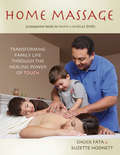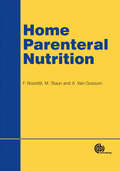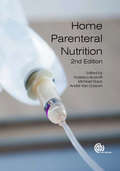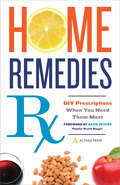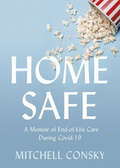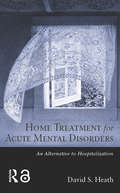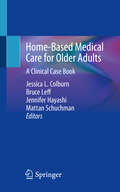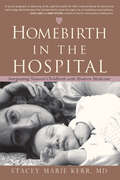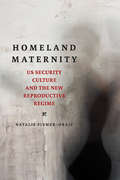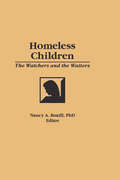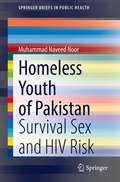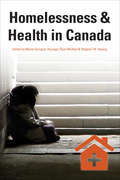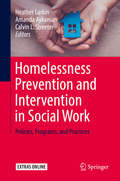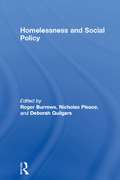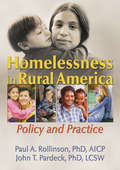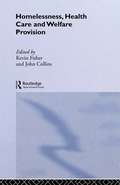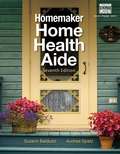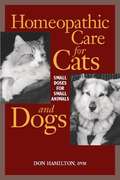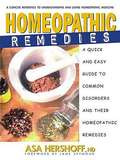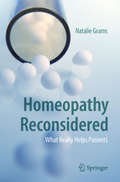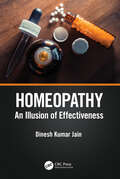- Table View
- List View
Home Massage
by Chuck Fata Suzette HodnettFocusing on its therapeutic properties and capacity to enhance health and intimacy in all relationships, this book demystifies the medium of massage and makes it accessible for everyone in the family. Designed for the nonprofessional with simple step-by-step instructions, it teaches the three principles that make learning massage easy and fun. Also included are ideas for bringing home massage into daily life and how to use these principles to share massage with infants, children, adolescents, spouses, and the elderly. By emphasizing the innate healing power of touch to reduce stress and improve the immune system, this practical manual provides the tools for achieving health, relaxation, and connection with loved ones.
Home Parenteral Nutrition
by Federico Bozzetti Michael Staun Andre Van GossumContaining contributions from leading international experts this book explores the life-saving treatment of home parenteral nutrition. It covers the complete scenario of home parenteral nutrition from its prevalence in different continents to clinical indications and the practical aspects of its management.
Home Parenteral Nutrition
by Federico Bozzetti Michael Staun Andre Van Gossum Patrick Patrick Johanne Johanne Federica Federica Janet Janet Daniela Daniela Simon Allison Marianna Marianna Asuncion AsuncionHome parenteral nutrition (HPN) is the intravenous administration of nutrients carried out in the patient's home. This book analyses current practices in HPN, with a view to inform best practice, covering epidemiology of HPN in regions including the UK and Europe, USA and Australia, its role in the treatment of clinical conditions including gastrointestinal disorders and cancer, ethical and legal aspects and patient quality of life.
Home Parenteral Nutrition
by Patrick Patrick Johanne Johanne Federica Federica Janet Janet Daniela Daniela Simon Allison Marianna Marianna Asuncion AsuncionHome parenteral nutrition (HPN) is the intravenous administration of nutrients carried out in the patient's home. This book analyses current practices in HPN, with a view to inform best practice, covering epidemiology of HPN in regions including the UK and Europe, USA and Australia, its role in the treatment of clinical conditions including gastrointestinal disorders and cancer, ethical and legal aspects and patient quality of life.
Home Remedies Rx: DIY Prescriptions When You Need Them Most
by Althea PressRelief is just an arm's reach away.Health ailments and injuries are bound to interrupt your day-to-day life when you least expect it. Home Remedies Rx offers safe and effective treatments when you them most.Whether you are battling insomnia, a headache, chapped lips, a bee sting, or acid reflux, Home Remedies Rx offers tried-and-true solutions to help alleviate everyday aches and pains, as well as tips for enhancing beauty and wellness. From the natural healing experts who brought you the New York Times bestseller Essential Oils for Beginners, Home Remedies Rx will help you treat today's ailments with time-tested wisdom.Home Remedies Rx offers effective, natural remedies at your fingertips, with: An easy-to-navigate A-to-Z reference guide to natural home remedies Profiles of more than 60 healing foods, household products, and essential oils Effective home remedies to treat more than 100 common ailments and address your beauty and wellness needs DIY treatments for prenatal, infant, and child-age ailments Natural home remedies to help your pets stay healthy too Save time, money, and trips to the doctor's office with this handy guide to home remedies.
Home Safe: A Memoir of End-of-Life Care During Covid-19
by Mitchell ConskyDuring a pandemic lockdown full of pyjama dance parties, life talks, and final goodbyes, a family helps a father die with dignity.In April 2020, journalist Mitchell Consky received bad news: his father was diagnosed with a rare and terminal cancer, with less than two months to live. Suddenly, he and his extended family — many of them healthcare workers — were tasked with reconciling the social distancing required by the Covid-19 pandemic with a family-based approach to end-of-life care. The result was a home hospice during the first lockdown. Suspended within the chaos of medication and treatments were dance parties, episodes of Tiger King, and his father’s many deadpan jokes. Leaning into his journalistic intuitions, Mitchell interviewed his father daily, making audio recordings of final talks, emotional goodbyes, and the unexpected laughter that filled his father’s final days. Serving as a catalyst for fatherly affection, these interviews became an opportunity for emotional confession during the slowed-down time of a shuttered world, and reflect how far a family went in making a dying loved one feel safe at home.
Home Treatment for Acute Mental Disorders: An Alternative to Hospitalization
by David S. HeathIn the U.S., when a patient is in need of rigorous psychiatric care, the first step is hospitalization. However, elsewhere in the world, psychiatric home treatment is proposed as an alternative. Model programs in Canada and the United Kingdom are publicly administered by community health agencies or teaching hospitals. Home Treatment for Acute Mental Disorders provides a review of the literature on home care and describes working programs around the world. This timely volume reviews treatment plans for different disorders with case illustrations, explains the administration of a PHC program and offers guidelines to case workers. It will be of interest to psychiatrists and policy makers working on the issue of patient hospitalization.
Home-Based Medical Care for Older Adults: A Clinical Case Book
by Bruce Leff Jessica L. Colburn Jennifer Hayashi Mattan SchuchmanAs the population of older adults in the U.S. continues to grow, medical house calls are increasingly part of a system of comprehensive home-based care for patients who have difficulty accessing office-.based care. Clinicians who have been trained mostly in office and hospital settings must adapt their usual approaches to accommodate a wide range of environmental, social, and physical circumstances that impact home-limited patients. Ideally, a comprehensive team of clinicians proficient in multiple domains of functional, social, and medical care can work together to address potential gaps in any one clinician’s expertise. Unfortunately, such teams are still rare. This book aims to equip individual clinicians with the interdisciplinary knowledge, skills, and perspective they need to provide the best care possible with limited formal interdisciplinary support. This book offers 20 patient cases drawn from the collective experience of experts in home-based medical care from highly respected academic and clinical programs across the United States. Each case demonstrates a scenario that is frequently encountered and/or very important in home-based medical care practice. Each scenario frequently proves to be challenging for many professionals because it requires an approach or leverages aspects of care delivery that most are not trained in. Additionally, each scenario reflects an approach to care that is enhanced by interdisciplinary input. Finally, each case lends itself to a practical problem-solving approach that could be accomplished by most home-based medical care providers, even in the absence of an interdisciplinary team. Written by interdisciplinary experts in geriatric home-based care, this book serves as both an educational tool for learners in all related disciplines as well as a quick reference for experienced clinicians looking to augment their existing house call “toolbox.”
Home-Prepared Dog and Cat Diets
by Patricia A. SchenckHome-Prepared Dog and Cat Diets, Second Edition provides an introduction to nutrition of the healthy dog and cat and an extensive discussion of medical disorders that can be managed in part through diet. Presenting easy-to-follow recipes that can be prepared at home, this new edition of Donald Strombeck's classic handbook has been completely rewritten by new author Patricia A. Schenck to reflect the latest nutritional recommendations based on current research. New chapter topics include feeding the puppy and kitten; feeding the pregnant or lactating dog or cat; feeding the senior pet; feeding the performance dog; and the role of diet in pets with cancer. Diets are now listed together in a cookbook style for ease of use, and recipes are adjustable for any size dog or cat, allowing exact nutritional values to be calculated. Nutrient content for protein, fat, carbohydrate, and fiber have been provided for every diet, along with the nutrient density. A companion website features downloadable spreadsheets with complete nutritional breakdowns for each recipe. Useful for both veterinarians and pet owners alike, Home-Prepared Dog and Cat Diets, Second Edition is a unique handbook written by an expert in the field providing an introduction to the nutritional management of dogs and cats with easy-to-use recipes for home-prepared diets. Clarification: Calcium Carbonate We've had some questions from readers regarding the use of the term "calcium carbonate," which is listed as an ingredient in a number of the diets found in this book, and therefore wanted to clarify what is meant by this ingredient. Baking soda comes in two forms: sodium bicarbonate and calcium carbonate. The sodium bicarbonate version is widely available as "baking soda" and is commonly used in baking, but none of the recipes in this book use it as an ingredient. The calcium carbonate version of baking soda is sometimes sold as "baking soda substitute" and sometimes referred to as simply "baking soda. " To avoid confusing sodium bicarbonate and calcium carbonate, any time the calcium carbonate type of baking soda has been used in a diet in this book, the ingredient includes the specific term "calcium carbonate. " There are several manufacturers of calcium carbonate baking soda; for example, Amazon carries the Ener-G Foods product baking soda substitute. Calcium carbonate can also be sold for garden use, which is non-food-grade, so to avoid the use of the garden product in foods, the term "baking soda" was used in this book instead to indicate that readers should be sure to select a food-appropriate ingredient.
Homebirth in the Hospital: Integrating Natural Childbirth with Modern Medicine
by Stacey Marie KerrThe personalized and empowering experience of a home birth can also occur in a hospital setting. This book presents fifteen powerful testimonies about this kind of emotionally satisfying birth. The stories show that expectant mothers can minimize fear and put technology where it belongs.Dr. Kerr focuses on the Five C's: Choice, Communication, Continuity, Confidence, and Control of protocols. Prospective parents will learn what questions to ask when searching for a provider and how to make their hospital birth the fulfilling experience they desire.
Homeland Maternity: US Security Culture and the New Reproductive Regime (Feminist Media Studies)
by Natalie Fixmer-OraizIn US security culture, motherhood is a site of intense contestation--both a powerful form of cultural currency and a target of unprecedented assault. Linked by an atmosphere of crisis and perceived vulnerability, motherhood and nation have become intimately entwined, dangerously positioning national security as reliant on the control of women's bodies. Drawing on feminist scholarship and critical studies of security culture, Natalie Fixmer-Oraiz explores homeland maternity by calling our attention to the ways that authorities see both non-reproductive and "overly" reproductive women's bodies as threats to social norms--and thus to security. Homeland maternity culture intensifies motherhood's requirements and works to discipline those who refuse to adhere. Analyzing the opt-out revolution, public debates over emergency contraception, and other controversies, Fixmer-Oraiz compellingly demonstrates how policing maternal bodies serves the political function of securing the nation in a time of supposed danger--with profound and troubling implications for women's lives and agency.
Homeless Children: The Watchers and the Waiters
by Jerome Beker Nancy A BoxillAt last, here is a compassionate, humane, and informative volume on the most unique and vulnerable group in our society today--homeless children. Homeless Children: The Watchers and the Waiters is unique because it offers an interdisciplinary approach to understanding the children and the enormously complicated causes of and solutions to their tragedy. The contributing authors discuss homeless children and the resolution of the problem, as well as the resulting policy and practice implications.From this single source of current research, policy, and practice information, you will better understand the circumstances of homelessness. You will also discover the impact of homelessness on children--the psychological effects on children’s development and behavior, the weakening of mother/child relationships, and the declining status of their physical health. Experts also describe the difficulties created by underfunded, poorly managed, and politically unpopular programs for homeless children, underscoring the need for a national policy to address the problem.Homeless Children: The Watchers and the Waiters is a thought-provoking and insightful book that must be read by professionals who work in human service agencies, sociologists, psychologists, health care workers, child care workers, teachers, and clergy. Policymakers, government officials, and child advocates must also read this masterful volume.
Homeless Youth of Pakistan: Survival Sex and HIV Risk (SpringerBriefs in Public Health)
by Muhammad Naveed NoorWhile homeless young people (HYP) are typically perceived as irresponsible and morally suspect individuals who lack essential social skills to navigate their lives, this book offers an alternative and more positive perspective. It demonstrates that HYP improvise with resources available on the streets to improve their social and financial status, although they experience significant social structural constraints. This ground-breaking text provides an analysis of social processes that contribute to young people’s homelessness, their engagement in sex work, their establishment of intimate partnerships, and sexual practices which may increase their risk of HIV and other sexually transmitted infections (STIs). The book demonstrates how the ongoing social and financial instability and insecurity neutralises HYP’s knowledge of HIV/STIs, and how financial considerations, fear of violence by clients, and social obligations in intimate partnerships contribute to their sexual risk-taking. The author argues that the conventional approach of promoting health through raising awareness regarding HIV/STI prevention may continue to bring less than promising outcomes unless we focus on how structural and contextual conditions operate in the backdrop and produce conditions less conducive for young people. Included in the coverage: factors that contribute to youth homelessnessfactors that shape sexual practice a Bourdieusian analysis of youth homelessness and sexual risk-takinga health promotion approach that can potentially reduce youth homelessness and their risk of HIV/STIs Homeless Youth of Pakistan: Survival Sex and HIV Risk will attract undergraduate and postgraduate students, and researchers interested in exploring issues such as youth homelessness, sexual risk-taking, and HIV/STIs.
Homelessness & Health in Canada (Health and Society)
by Manal Guirguis-Younger Stephen W. Hwang Ryan McNeilHomelessness & Health in Canada explores, for the first time, the social, structural, and environmental factors that shape the health of homeless persons in Canada. Covering a wide range of topics from youth homelessness to end-of-life care, the authors strive to outline policy and practice recommendations to respond to the ongoing public health crisis. This book is divided into three distinct but complimentary sections. In the first section, contributors explore how homelessness affects the health of particular homeless populations, focusing on the experiences of homeless youth, immigrants, refugees and people of Aboriginal ancestry. In the second section, contributors investigate how housing and public health policy as well as programmatic responses can address various health challenges, including severe mental illness and HIV/AIDS. In the final section, contributors highlight innovative Canadian interventions that have shown great promise in the field. Together, they form a comprehensive survey of an all too important topic and serve as a blueprint for action.
Homelessness Prevention and Intervention in Social Work: Policies, Programs, and Practices
by Calvin L. Streeter Heather Larkin Amanda AykanianThis important text provides a comprehensive survey of homelessness in America: its scope and causes, its diverse populations, and the array of responses at the individual, community, and systems levels. Expert contributors explore the links between trauma and homelessness, the cycle of homelessness and health/mental health problems, and barriers preventing people from accessing services. Case studies of effective programs and practices focus on science-based interventions, broad understanding of client needs, and close coordination between systems and agencies. Finally, specialized chapters discuss issues and experiences common to homeless youth and young adults, including housing instability on college campuses and empowerment-based strategies for engaging youth voice in programming . Included in the coverage:Homelessness and health disparities: a health equity lensAffordable housing and housing policy responses to homelessnessStreet talk: homeless discourses and the politics of service provisionMultisectoral collaborations to address homelessnessTrauma-informed care in homelessness service settings: challenges and opportunitiesIncorporating youth voice into services for young people experiencing homelessnessHomelessness Prevention and Intervention in Social Work fills a critical gap in the social work curriculum as a main or a supplementary text. It also makes an accessible resource for clinicians and community practitioners seeking current knowledge on the topic, practical approaches to working with clients experiencing homelessness, and useful information for effective program and policy design.
Homelessness and Social Policy
by Roger Burrows Nicholas Pleace Deborah QuilgarsThe problem of homelessness is deeply emblematic of the sort of society Britain has become. What other social phenomena could better epitomise the end of modernity than our seeming inability to adequately respond to the most basic needs - shelter, warmth, food - of substantial numbers of our 'citizens'? Homelessness and Social Policy offers a dispassionate analysis of the problem of homelessness and the policy responses it has so far invoked. By reviewing theoretical and legal conceptualisations of homelessness and presenting extensive statistical analyses, this book considers the impact of the experience of homelessness and the policy responses. Homelessness and Social Policy will prove to be invaluable to students of social and public policy, health studies, housing studies and sociology.
Homelessness in America: Perspectives, Characterizations, and Considerations for Occupational Therapy
by Kathleen Swenso Miller Georgiana L Herzberg Sharon A RayLearn how to better address the needs of the homelessThe causes of homelessness are complex and varied. Homelessness in America provides an overview of the state of research on the homeless population from an occupation and societal participation perspective. This important resource explores the systems of care in which homeless services are organized, the tailoring of services to meet the needs of diverse types of homeless, the newest trends in services, and crucial funding sources. Research is comprehensively examined from an occupation-based perspective, including studies on specific issues pertaining to various homeless populations. This in-depth discussion provides a vital understanding of homelessness using a client-centered and strengths-based approach in occupational therapy. Much of the research and writings of occupational therapists who work with homeless populations has been scattered throughout various diverse publications. Homelessness in America: Perspectives, Characterizations, and Considerations for Occupational Therapy gathers into one useful volume important insights, practical strategies, and valuable research into the many challenges concerning homelessness. Various effective interventions are discussed in depth. Several leading authorities explore current issues and offer illuminating case studies, extensive reference lists, and helpful tables of funding sources.Topics in Homelessness in America include: results of an Internet-based survey of assessment tools used with the homeless a critical examination of the assumptions of who becomes homeless-and why typologies of homelessness current trends in service delivery federal organization and sources of funding for services exploratory study of occupational concerns and goals of homeless women with children study illustrating the value of the theory of Occupational Adaptation mother-toddler interactions in transitional housing the role of occupational therapy in the youth homelessness problem homeless youths&’ after-school and weekend time use guiding intervention by using the Model of Human Occupation (MOHO) productive role involvement at Project Employ study on life skills interventions with effective recommendations much moreHomelessness in America is insightful, important reading for occupational therapy educators, students, practicing occupational therapists, program directors of services to the homeless, and policymakers.
Homelessness in Rural America: Policy and Practice
by Paul A Rollinson John A PardeckTake your knowledge of the needs of the rural homeless to the next levelThis groundbreaking text examines research methodologies for studying the homeless, rural homeless policy, and the lives of today&’s rural homeless. It gives a thorough overview of the issues faced by this unique sector and outlines specific avenues for further research. The authors&’ insightful data analysis, real life findings, and specific case examples offer useful and research-based approaches to improve the difficult situation of the rural homeless, using a family health approach well suited to addressing the issues that affect them. Since services for the homeless are most often located in cities, the rural homeless are at a physical disadvantage. Because they are unable to utilize the services provided for the urban homeless, their needs often go unmet. Researchers and social service professionals face the same dilemma. Homelessness in Rural America addresses these issues by making vital research techniques, difficult-to-find data, and strategies for practice easy to access, understand, and put to use.Homelessness in Rural America: Policy and Programs examines: the current condition of the rural homeless factors that can increase the probability of a rural individual becoming homeless the influence of welfare programs on the rural homeless issues faced by the rural homeless and how a family health approach can treat these issues the research methodology used to study the rural homeless micro- and macro-level solutions to rural homeless problemsStudents and educators will benefit from Homelessness in Rural America&’s micro- and macro-level approaches to intervention. Policy planners will discover the further complications that have arisen from welfare programs. As the homeless population continues to increase, Homelessness in Rural America becomes even more essential. The rural homeless are often overlooked in the social sciences literature, and this book fills that void with its rare and well-organized information.
Homelessness, Health Care and Welfare Provision
by John Collins Kevin FisherHomelessness, Health Care and Welfare Provision is the first known publication in which service providers examine the particular difficulties encountered by homeless people in gaining access to healthcare, both in Britain and the US. Specific chapters examine the complex issue of mental health and homelessness, responses to single homeless people with drink-related problems and the particular problems experienced by young single homeless people and homeless women. _
Homemaker Home Health Aide
by Suzann BalduzziHOMEMAKER HOME HEALTH AIDE, 7th Edition helps you prepare for a meaningful career in the growing field of home health. Using a clear, supportive approach, the authors show you how to care for a variety of sensitive client populations, from infants and the elderly to special needs and the terminally ill, and become a valued member of the home health care team. In addition to the topics of nutrition, safety, infection control, and bodily systems, the author imparts the practical skills you need to deliver high-quality personal care. Coverage also includes hundreds of practice questions to help you prepare for state certification exams (where applicable). Whether you are new to the industry or in need of a refresher, you will find HOMEMAKER HOME HEALTH AIDE, 7th Edition a key resource for becoming a caring, dedicated, and skilled paraprofessional.
Homeopathic Care for Cats and Dogs: Small Doses for Small Animals
by Don Hamilton"In his book, (Dr Hamilton) carefully and clearly lays down the essential knowledge needed to use homeopathy successfully. To read this book is to prepare you to help your animal with the many day-to-day vicissitudes of life... take some time, read this book carefully, and learn of one of the greatest discoveries in the history of medicine. We are fortunate to have a healer of Dr Hamilton's stature take us on this Journey." Richard Pitcairn, DVM, PHD.
Homeopathic Remedies
by Asa HershoffOrganized alphabetically by disorder, this convenient reference clearly describes all you need to know about homeopathy and the treatment of numerous disorders. For each condition, many possible remedies are suggested so you can find the one that most accurately fits your symptoms. From food poisoning to varicose veins, this book provides detailed homeopathic solutions for a wide range of ailments.
Homeopathy Reconsidered: What Really Helps Patients
by Natalie GramsHomeopathy is over 200 years old and is still experiencing an uninterrupted influx of new practitioners and patients. Many patients and therapists swear by this "alternative healing method", which in some countries is even financed by health insurances. This seems completely incomprehensible to critics: For them it is clearly evident that homeopathy is hopelessly unscientific and has at best a placebo effect. The positions of supporters and opponents seem to be just as immutable as they are incompatible. This book answers some essential and fascinating questions: What remains of the founding ideas of homeopathy in 21st century medicine? Does it really work and, if so, how? Which of the original theories can we still apply today with a clear conscience and use for the benefit of patients and the healthcare system? Where does homeopathy have its limits and does it indeed need to be critically reconsidered and evaluated? The author has dealt with the points of criticism for years, but at the same time also takes seriously the wishes and concerns of patients who often feel insufficiently cared for by conventional medical practice. Against the background of her own personal history, her book attempts to bridge the gap between these two traditionally opposing camps.
Homeopathy as Energy Medicine: Information in the Nanodose
by Richard Grossinger• Comprehensively examines what homeopathy is and places the practice within the larger framework of energy medicine and microdose effects• Lays out the principles and origins of homeopathy, explaining its discovery and development by Samuel Hahnemann• Explores the rise and fall and current rise in popularity of homeopathy over the years and its resonance during the COVID-19 pandemicHelping first-time patients as well as longtime devotees gain a deeper understanding of just what homeopathy is, Richard Grossinger presents a comprehensive overview of the healing art, explaining its essential philosophy and methodology and showing how it relates to the broader concepts of energy medicine and nanodose treatments. He introduces homeopathy&’s basic framework and explores its three central principles: the Law of Similars, microdose transmission of energetic information, and potentization. Addressing the many critiques of homeopathy, he looks at the power of the placebo effect and offers a comparison of homeopathy to other alternative and mainstream healing modalities.Placing homeopathy in a historical context, he explores doctor Samuel Hahnemann&’s discovery of homeopathy in the late 18th century and looks at medical and pharmaceutical systems that preceded homeopathy, such as alchemy, Paracelsan herbalism, and Greek and Roman medicine. He examines homeopathy&’s rise and fall in popularity over the years, including its renaissance in early 19th-century North America and its revival in the counterculture of the 1970s. He looks at modern evolutions of homeopathy, including Dr. Rajan Sankaran&’s "sensations" theory, homeopathy&’s resonance during the COVID-19 pandemic, the concept of the pill-less pharmacy, the microdose basis of astrological charts, and psychic homeopathy.Presenting a contemporary understanding of homeopathy as energy medicine, this book offers everything needed to begin self-healing with the power of the nanodose.
Homeopathy: An Illusion of Effectiveness
by Dinesh Kumar JainTaking a critical view, Homeopathy: An Illusion of Effectiveness is a treasure trove of information regarding the homeopathic system of medicine, reasoning through various unanswered questions concerning its principles and the scientific basis of its remedies. This book posits that the principles of homeopathy are inaccurate and homeopathic drugs have no therapeutic utility. Features: • Includes studies, observations, analysis, and conclusions of Dr. Samuel Hahnemann, the founder of homeopathy • Proves that principles of homeopathy are scientifically baseless and homeopathic drugs have no therapeutic effect • Provides a platform for creative and rational thinking • Promotes evidence-based medicine This book is the only one of its kind, explaining how Hahnemann framed the laws of this therapeutic system inaccurately due to lack of knowledge. At present, homeopathy is misleading the public and increasing morbidity and mortality because it is interfering with the application of modern medical science. This book will be useful in the medical community as well as the non-medical community, dispelling several myths associated with homeopathy by developing a rational approach based on scientific facts.
